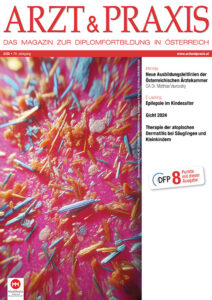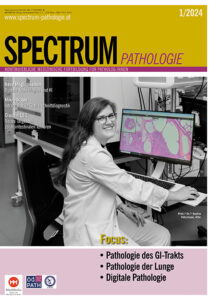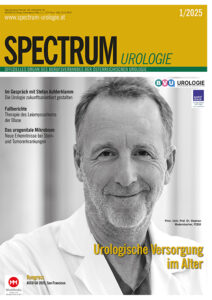Art of Urology – Prostatakarzinom: PSA and beyond – Part I Limitations of PSA and its derivatives
AbstractThe wide availability and application of total PSA (prostate-specific antigen) measurements revolutionized screening for prostate cancer (PCa) and ushered in the PSA era, resulting in detection of prostate cancer at a localized stage at which there was a greater chance for cure. However, the ubiquitous application of PSA screening has also led to over-detection and overtreatment. A large concerted effort has been made to improve our methods to assess therapeutic responses and to guide molecular-targeted therapies of PCa. An integrated approach with measurements of different molecular forms of PSA, in combination with genetic and urine-based biomarkers, holds promise for improvements in the screening for and monitoring of PCa. The advent of high-throughput technologies is allowing for comprehensive identification of potential biomarkers and molecular targets for PCa. The challenge remains to optimize the measurements of these targets, to evaluate their impact for therapeutic drug development, and finally, to translate these advances into improved clinical management for patients with PCa. KurzfassungDurch die Verwendung des Gesamt-PSA wurde Prostatakarzinom-Screening möglich, und es kam zur PSA-Ära. Durch das Screening beziehungsweise die Früherkennung kam es zu einem Rückgang der prostatakarzinomspezifischen Mortalität, es führte aber auch gleichzeitig zu einer Überdiagnostik und -behandlung. Um Lezteres und das Monitoring des Prostatakarzinom-Patienten zu verbessern, wurden zahlreiche neue molekulare Marker entwickelt. Ein integrierter Ansatz mit Messungen verschiedener molekularer Formen des PSA im Blut in Kombination mit genetischen Biomarkern sowie Biomarkern im Urin gelten als viel versprechend, das PCa-Screening und die Diagnose des PCa zu verbessern. |
In Western societies, prostate cancer (PCa) is the most common solid malignancy and the second leading cause of cancer death in men. The wide availability of total prostate-specific antigen (PSA; previously known as human kallikrein 3, hK3) measures revolutionized PCa screening and ushered in the PSA era. This has resulted in a decrease in PCa metastasis and the ensuing death. However, the ubiquitous application of PSA screening has also led to over-detection and over-treatment.
The lifetime risk of being diagnosed with PCa is estimated at ~18%, whereas that for death from PCa is ~3%. In addition, PSA is neither cancer specific nor a surrogate for the biological behavior of PCa. An elevated PSA level can reflect the presence of PCa, but it can also be caused by benign prostatic hyperplasia (BPH), infection, and/or chronic inflammation. Virtually all prostate epithelial cells, whether normal, hyperplastic or cancerous, synthesize PSA. Therefore, there has been a concerted effort to identify and validate novel PCa biomarkers.
Total PSA and its limitations
Neoplastic cells produce somewhat lower and varying tissue levels of PSA compared to benign epithelial cells, although both conditions result in increases in total PSA in the blood.[1] Therefore, it has been suggested that total PSA should be considered as a marker of BPH-related prostate volume, growth, and outcome, rather than a reliable marker of PCa itself.[1] Moreover, some aggressive PCas do not produce PSA.
PSA levels are inherently variable, thereby affecting the interpretation of any single assessment.[2] The variations that can be seen for total PSA are both analytical (i.e., pre-analytical sample handling, laboratory processing, assay performance, and standardization) and biological (i.e., metabolism, renal elimination, medication, physical and sexual activity, prostate size and integrity). Oscillations of up to 20%-30% in the total PSA serum concentration range of 0.1 ng/mL to 20 ng/mL can be due to biological variation.[ 3, 4] Furthermore, the use of different detection assays is another important source of variation. Differences in assay standardization can give an artifactually high or low estimations of total PSA and total PSAV.[5-7] These assays are not interchangeable, and caution should be exercised when comparing results from different commercial total PSA assays. Patients and physicians should be aware of which assay is used each time a total PSA measurement is performed, and efforts should be taken to use the same assay at each visit. In addition, studies of total PSA kinetics over time using different assays should be interpreted with caution. Of note, there is an expected 20% lower value when the World Health Organization (WHO) standard is adopted and laboratories should be obliged to give the name of the PSA assay used on laboratory reports, as well as stating the assay-specific reference range and the type of master calibration (e.g., WHO standardized or traditional calibration).[ 8-10]
The effects of previous BPH treatment on total PSA remains mostly unpredictable. For example, the effects of the commonly used 5-α-reductase inhibitors on the predictive value of total PSA kinetics for tumor progression are uncertain. As 5-α- reductase inhibitors are known to decrease PSA levels by ~50% and to mostly suppress the benign components of PSA secretion, they might enhance the utility of total PSA measures.[11] In addition, by shrinking the prostate gland, the 5-_-reductase inhibitor finasteride has been suggested to increase the likelihood of detecting a small cancer on needle biopsy.[11]
This large normal variability of total PSA requires larger changes between two consecutive measurements to distinguish pathological changes from changes resulting from analytical and biological variations. Nixon et al. calculated the coefficient of variation of total PSA over two weeks, and demonstrated that a change between two total PSA measurements of approximately 25% indicated a significant change.[12, 13] Bunting et al. reported a critical difference between total PSA measures, which they defined as the minimum percentage change between two consecutive measurements that suggests a significant change beyond normal variation, which was close to 60% over a time period of one year.[14] Bruun et al. recently assessed the longterm variability of the different forms of PSA at several different total PSA levels in a randomly selected population of asymptomatic and apparently healthy men whose total PSA levels were <2.0 ng/mL at the end of the eight-year observation period.[15] They found that the total intra-individual variation of total PSA was much less than that reported by Bunting et al.[14] and somewhat higher than the intra-individual variations for either free PSA or percentage free PSA. This suggests that the free PSA concentrations in the blood might vary less than the complexed PSA concentrations, which is the major contributor to the total PSA levels. One explanation is that free PSA and complexed PSA have different elimination pathways, and hence different elimination rates.[16-19]
Optimal total PSA cut-off values
No single total PSA cut-off separates men at high risk from PCa from men at low risk, nor men affected with highgrade disease from those with low-grade disease. At a total PSA cut-off of ≥4 ng/mL, a significant number of PCas remain undetected.[20-23] In addition, intervention at lower total PSA levels has been reported to improve patient outcome.[24, 25] Catalona et al. found that 22% of men with a normal digital rectal examination (DRE) and a total serum PSA level between 2.6 ng/mL and 4.0 ng/mL have PCa, and 81% of them have organ-confined disease.[26] Data from the Prostate Cancer Prevention Trial (PCPT) revealed that as many as 15% of men with normal DRE and a total serum PSA <4.0 ng/mL have PCa.[20] Among men with total PSA levels ≤0.5, 0.6-1.0, 1.1-2.0, 2.1-3.0, and 3.1-4.0 ng/mL, PCa was detected in 6.6%, 10.1%, 17.0%, 23.9%, and 26.9%, respectively. Moreover, approximately 25% of these men had a tumor with a Gleason score of 7 or higher. These and other investigators have demonstrated that increasing levels of total PSA are associated with increasing probability of PCa risk within the 0.0 ng/mL to 4.0 ng/mL PSA interval.[20, 22, 27] There is no total PSA threshold at the age of 62-91 years below which PCa can be ruled out with high specificity.[20] No single total PSA cut-off separates men with “significant (high grade, high volume) cancer from those with low-grade, possibly insignificant, cancer. Similarly for PCa presence, high-grade PCa can be found in men with low total PSA levels.
On the other hand, to date, there is no evidence that lowering the total PSA threshold below 4 ng/mL improves the long-term survival in men with PCa. Lowering the total PSA threshold combined with decreasing the age of total PSA screening might be beneficial for men who are at an increased risk for PCa (i.e., strong family history of PCa and/or African-American race). However, consideration must be given to the possibility that lowering the total PSA threshold can result in unnecessary biopsies and an increased detection of insignificant cancers. Finally, determination of the optimal, institution-specific, and management-guiding threshold involves not only clinical and epidemiological features, but should also consider the social and psychological implications of prostate biopsies and possible PCa detection.
The difficulty in selecting a cut-off to define what constitutes an abnormal total PSA suggests that total PSA is most useful as a continuous variable, to provide a spectrum of PCa risk. Therefore, we prefer to include total serum PSA levels in an overall estimate of the risk of cancer, to be able to inform the patient of his particular risk, and then to make a shared decision about a biopsy.[20-22, 28-32] Nam et al., for example, developed a model that predicts the risk for an individual for PCa from a cohort of 3,108 men who underwent prostate biopsy for the first time.[32] This model comprises factors that can be easily determined at the time of screening, such as age, ethnicity, family history of PCa, presence of urinary symptoms, total PSA, percent free PSA, and DRE. The combination of all of these risk factors improved the predictive accuracy of a base model from 0.62 to 0.74. The main advantage of this and other predictive tools[28] is that clinicians can assess PCa risk on an individual basis and make the relevant management decisions. However, despite the reasonable accuracy, as with all predictive tools, the exact probability cut-off for undergoing or foregoing a biopsy is left to the patient and his treating physician, a decision that should be individualized.
Long-term prediction of future risk of PCa using total PSA: Several studies have suggested that total PSA levels are associated with the risk of PCa years, or even decades, before its diagnosis. The first long-term prediction study reported that total PSA levels >2.5 ng/mL predicted diagnosis of PCa over the subsequent decade, although this was limited by the small number of PCa cases (n = 44) and by the degradation of the total PSA in archived serum samples.[33] In a prospective study that involved a large number of cases, the lead-time between total PSA levels 4 ng/mL and the subsequent clinical diagnosis of PCa was estimated at 5.5 years.[34] Similarly, Fang et al. studied the risk of PCa diagnosis in a cohort of 549 men following a baseline total PSA measurement at the age of 40- 60 years, where they provided a median follow-up of 13 years.[35] They concluded that total PSA above the age-adjusted median carried a relative risk of subsequent PCa diagnosis of 3.6.
Two larger studies extended the prediction models to lower total PSA ranges and longer follow-up intervals. Loeb et al. examined 1,178 men in their 40s who had risk factors for PCa.[36] The risk of subsequent PCa diagnosis was 14.6-fold higher for men with a baseline total PSA level between 0.7 ng/mL and 2.5 ng/mL, compared to men with total PSA <0.7 ng/mL. Lilja et al. assessed PCa risk among 21,277 men younger than 50 years when they attended the Malmö Preventive Medicine study, a cardiovascular risk assessment study.[37] The investigators measured total PSA levels in archived plasma obtained from 462 participants who were diagnosed with PCa within a median of 18 years from the start of the study, and from 1,222 matched controls. Total PSA levels at the age of 44-50 years were very strongly associated with the likelihood of developing PCa up to 25 years later. The odds ratio for a PCa diagnosis at a total PSA level of 0.51 ng/mL to 1.0 ng/mL was 2.51, compared to a total PSA ≤0.50 ng/mL, which corresponded roughly to the population average. This odds ratio increased to 7.02 for a total PSA of 1.0 ng/mL to 1.5 ng/mL, and then further up to 19.01 for a total PSA of 2.01 ng/mL to 3.0 ng/mL, again, compared to a total PSA ≤0.50 ng/mL. In a follow-up study, they further showed that the total PSA level at the age of 44-50 years predicts the likelihood of developing advanced PCa, which was defined as either locally advanced (clinical T3 or higher) or metastatic disease at the time of diagnosis.[38] In another analysis of the Malmö Preventive Medicine study cohort, the prognostic accuracy of PSA (both total PSA and complexed PSA; see below) decreased with age.[39] Here they hypothesized that these findings resulted from a greater prevalence of BPH (and therefore of non-cancer-related total PSA increases) among older men.
An analysis of the same cohort demonstrated that PSA at 60 years of age is an extremely strong predictor of the risk of PCa metastasis (area under the curve [AUC] 0.86) and death (AUC 0.90) by the age 85 years. Almost all of the deaths (90%) occurred in men in the top quartile of PSA levels (>2 ng/mL); men with PSA below the median (<1 ng/mL) had an extremely low risk of clinically relevant PCa by the age of 85 years (0.5% risk of metastasis, 0.2% risk of death from PCa).This suggests that at least half of these men can be exempted from PCa screening at the age of 60 years, with early detection efforts focusing on the sub-group of men at elevated risk.[40] In summary, these studies indicate that the men who will eventually develop PCa can have increased total PSA levels years or decades before the cancer is diagnosed. These total PSA levels might reflect the long duration of prostate carcinogenesis, or they might reflect a causal role of total PSA in PCa development and/or progression. A total PSA measurement before the age of 50 years could help to riskstratify men for their frequency and/or type of later PCa screening; a PSA measure at 60 years of age might determine which men need to continue with screening.
Prostate-specific antigen derivatives
Enhancing the diagnostic accuracy of total PSA, and particularly its specificity, is crucial, as a higher specificity would reduce the number of biopsies that might be performed in men who are not affected by PCa. Several different strategies have been investigated, including the use of age-specific total PSA cut-offs, total PSA density, total PSA density of the transition zone, total PSAV, and measurement of various molecular forms of PSA.[28, 41-43] In this section, we will focus on total PSAV and the measurements of various molecular forms of PSA.
Total PSA velocity
The total PSAV refers to serial evaluation of total serum PSA concentrations over time.[44, 45] Different methods for the calculation of total PSAV are available (e.g., based on the first and the last measured values only, or on a regression line through all of the available measurements; based on normal or logarithmic values), although only small differences in predictive value have been found between these derivatives. Connolly et al found that using all of the available total PSA measurements in a linear regression analysis should be the method of choice for calculating total PSAV.[46] When using the first and last measurements only, these should at least be separated by a sufficiently long time period.
Carter et al. showed that patients with BPH show a linear increase in total PSA levels over time, whereas patients with PCa have an initial linear increase that is followed by an exponential rise that can occur approximately 5 years before PCa detection.[44] In men with an initial total PSA level between 4 ng/mL and 10 ng/mL, a total PSAV cut-off value of 0.75 ng/mL per year provided a sensitivity and specificity for PCa of 79% and >90%, respectively. If the initial total PSA concentration is less than 4 ng/mL, the specificity of total PSAV remained >90%, although the sensitivity dropped to 11%. These data were questioned using relatively short total PSA intervals of 1 year and 2 years.[47] Subsequently, Carter et al. showed that total PSAV values are only useful if a minimum of three consecutive measurements are taken over a two-year period.[48] While the specificity of the total PSAV is high, its sensitivity is too low to advise against prostate biopsy in a patient with an elevated total PSA level who is otherwise healthy and a good candidate for curative therapy. Other limitations of total PSAV include imprecision due to biological and analytical intra-individual variability (see above: “Total PSA and its limitations) and total PSA stability.
Prospective screening studies have reported that total PSAV does not appear to add diagnostic value for PCa detection beyond that of a single total PSA level. In an analysis of the PCPT data, Thompson et al. found that when total PSAV was used alone it was an independent predictor of PCa presence and aggressiveness.[21] However, when total PSAV was adjusted for the effects of total PSA and other standard variables, it lost its independent predictive value. Similarly, the first two screening rounds of the Rotterdam section of the European Randomized Study for Screening for Prostate Cancer found that total PSAV did not improve accuracy when combined with total PSA in a prospective setting.[49, 50] A recent analysis from the Prostate, Lung, Colon, and Ovarian cancer screening trial showed that although total PSAV was an independent predictor of high-grade disease, the addition of total PSAV to total PSA only slightly increased its performance for prediction of highgrade tumors.[51] Using a large population-based cohort of men in early middle age who were likely to have a low incidence of BPH, Ulmert et al. found no benefit for the calculate of total PSAV or of any other form of PSA over total PSA for long-term PCa prediction.[52] Of note, the predictive value of total PSAV alone was 71.2%, while the predictive value of a single total PSA was higher (77.1%), and the combined model that included both total PSAV and total PSA did not alter the predictive accuracy. This observed lack of additional predictive value for total PSAV indicates that total PSA levels do not increase sharply before PCa diagnosis, but instead they rise gradually and slowly over many years, also in those men who later present with advanced PCa.
Several studies have shown that high pre-treatment total PSAV is strongly associated with poor disease-specific survival following diagnosis, and this can help in the identification of men with low total PSA values who are at increased risk of harboring a potentially lethal tumor.[53-56] Carter et al. found a strong association between survival and higher total PSAV as early as 10-15 years before diagnosis in the Baltimore Longitudinal Study of Aging project.[56] Based on these findings, they proposed that a total PSAV threshold of 0.35 ng/mL per year should be used in screening men with low total PSA levels, to increase the detection of potentially lethal tumors while still in the window of curability. These data have prompted debate as to whether this would suffice as evidence to warrant the National Comprehensive Cancer Network to recommend a prostate biopsy if the total PSAV is greater than 0.5 ng/mL per year.[57] However, in an analysis of the PCPT data, Vickers and colleagues showed that biopsies for men with low PSA but elevated PSAV led to a large increase in unnecessary biopsies without detecting an important number of clinically significant cancers.[58]
D’Amico et al. reported that men with a pre-operative total PSAV greater than 2.0 ng/mL per year had a 9.8-fold increased relative risk of death from PCa than men with a lower total PSAV.[53] This analysis included a low number of events; accordingly, it is impossible to tell whether PSAV adds predictive value to standard predictors such as stage, grade and absolute level of PSA. In a more recent study, these investigators reported that total PSAV was also significantly associated with the risk of PCa-specific mortality following external beam radiation therapy.[54] Conversely, using data from 267 Scandinavian men with localized PCa and baseline total PSA levels <50 ng/mL, Fall and colleagues found that although prognostically relevant, baseline total PSA levels and relative total PSAV in the first two years following diagnosis did not accurately predict which patients would have a lethal PCa outcome.[59] Several other studies have found that PSAV does not aid in PCa prediction in men treated by radical prostatectomy[ 60, 61] or conservatively[62]. It may be that the observation period necessary for obtaining a valid calculation of total PSAV that is not disturbed by considerable short-term fluctuations is too long, or that the number of total PSA measurements needed is too high for use in clinical practice. In addition, total PSAV might not correlate with early tumor progression, but might only represent an indicator of an aggressive disease for which the window of curability has already closed. Furthermore, a quickly rising total PSA is more common in men with a high starting total PSA level.[63] This proportion of men is expected to be much smaller in a screened cohort than in a clinically diagnosed cohort. PSAV is a practical parameter after treatment, when PSA is a sensitive measure for PCa; its value in men with a prostate, in whom rises in PSA can be cause by benign disease, remains to be established.
Conclusions
The introduction of total PSA into clinical practice has resulted in early detection and reduced mortality from PCa.[64] However, PCa screening remains controversial, because of the risk of over-diagnosis, reduced mortality, and over-treatment, and the inability to detect a significant proportion of dangerous tumors.
A large concerted effort has been made to improve and/or monitor the activity of PCas and to guide molecular targeted therapies and/or assess therapeutic responses. An integrated approach with blood-based measurements of different molecular forms of PSA in combination with genetic and urine biomarkers holds promise for improvements in the screening for and diagnosis of PCa. In our next report, we will discuss the promising novel blood-based biomarkers.























































































